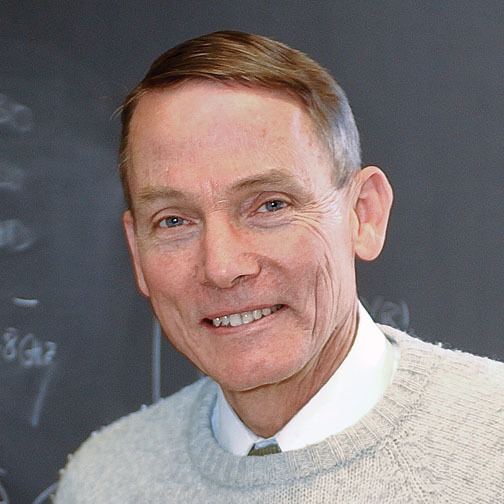Role Physicist Fields Atomic physics | Notable students John W. Farley Name William Happer | |
 | ||
Thesis Frequency shifts in atomic beams resonances (1964) Notable awards Davisson–Germer Prize in Atomic or Surface Physics Books Optically Pumped Atoms Similar People Richard Lindzen, Patrick Moore, Judith Curry | ||
Physicist william happer schooled the cnbc crowd on global warming
William "Will" Happer (born July 27, 1939) is an American physicist who has specialized in the study of atomic physics, optics and spectroscopy. He is the Cyrus Fogg Brackett Professor of Physics, Emeritus, at Princeton University, and a long-term member of the JASON advisory group, where he pioneered the development of adaptive optics. From 1991 to 1993, Happer served as director of the Department of Energy's Office of Science as part of the George HW Bush administration.
Contents
- Physicist william happer schooled the cnbc crowd on global warming
- William happer climate an extraordinary popular delusion
- Early life
- Education
- Career
- Climate change
- Political
- Honors
- Selected publications
- References

William happer climate an extraordinary popular delusion
Early life

Happer was born in Vellore, British India, the son of Dr. William Happer, a Scottish medical officer in the Indian Army, and Dr. Gladys Morgan Happer, a medical missionary for the Lutheran Church of North Carolina. Happer spent the years of World War II with his mother in Oak Ridge, Tennessee. After the war and a return to India, his family emigrated to North Carolina.
Education

He studied physics at the University of North Carolina, graduating in 1960. He earned his doctorate at Princeton University in 1964.
Career
His academic career started at Columbia University, where he became a full professor and director of the Columbia Radiation Laboratory. In 1980, he left to go to Princeton, where he became Class of 1990 Professor of Physics. In 1991, he joined the United States Department of Energy, where he was the director of its research budget of $3 billion. In 1993, he returned to his position at Princeton, where he became the chair of the University Research Board in 1995.
Happer describes his laboratory's research interests in atomic physics: "we're interested in the mechanisms that limit the performance of optical pumping systems, such as atomic clocks, magnetometers, and laser guide-star adaptive optics systems."
Happer joined the JASON advisory group in 1976, and he continues to be active there. Happer is credited with a key insight in 1982 that made adaptive optics possible: there is a layer of sodium in the mesosphere, at around 90 to 100 km of elevation, which could be lit by a laser beam to make an artificial guide star. His idea was tested successfully by DARPA but classified for possible military applications. The military-designed technology was partially unclassified in 1991, after the same idea was independently proposed by two French astronomers. In 1994, Happer and co-authors published a declassified version of the JASON reports on adaptive optics. Happer was chairman of the steering committee for JASON, 1987–1990.
Also, he has had numerous other assignments: trustee of the MITRE Corporation, the Richard Lounsbery Foundation and the Marshall Institute. He is also chairman, since 2006, of the last. He co-founded Magnetic Imaging Technologies Inc. in 1994.
Climate change
Happer has stated that “Some small fraction of the 1° C warming during the past two centuries must have been due to increasing CO2, which is indeed a greenhouse gas”, but argues that “most of the warming has probably been due to natural causes.” Other scientists dispute that view. Michael Oppenheimer, the lead author of the fourth report of the Intergovernmental Panel on Climate Change (IPCC) said that Happer’s claims are “simply not true” and that the preponderance of evidence and majority of expert opinion points to a strong anthropogenic influence on rising global temperatures. Climate Science Watch published a point-by-point rebuttal to one of Happer’s articles. A petition that he coauthored to change the official position of the American Physical Society to a version that raised doubts about global warming was overwhelmingly rejected by its membership.
In May 2013, Happer and Harrison Schmitt published an op-ed in the Wall Street Journal, "In Defense of Carbon Dioxide," in which they termed elevated atmospheric CO2 "a boon to plant life." It was described in the Columbia Journalism Review as "shameful, even for the dismal standards" of the editorial page, which is known for its denialism of climate science.
In December 2015, Happer was targeted in a sting operation by the environmental activist group Greenpeace; posing as consultants for a Middle Eastern oil and gas company, they asked Happer to write a report touting the benefits of rising carbon emissions. Happer asked the fee to be donated to the climate-change skeptic organization CO2 Coalition, which suggested that he reached out to the Donors Trust to keep the source of funds secret; hiding funding in that way is lawful under US law. Happer acknowledged that his report would probably not pass peer-review with a scientific journal.
Political
In 2017 following the election of Donald Trump into office, Happer met with Trump to discuss his potential role of being his science adviser and said that he would take the job if it was offered. Happer described Trump as "very attentive" and that the president's concerns "were that of a technically literate person." Hannah Devlin of The Guardian wrote that Happer "supports a controversial crackdown on the freedom of federal agency scientists to speak out about their findings, arguing that mixed messages... have led to people disregarding all public health information."
Honors
He is a fellow of the American Physical Society and the American Association for the Advancement of Science and a member of the National Academy of Sciences. He received an Alfred P. Sloan fellowship in 1966, an Alexander von Humboldt award in 1976, the Herbert P. Broida Prize in 1997, the Davisson-Germer Prize and the Thomas Alva Edison patent award in 2000. In 2003, he was named the Cyrus Fogg Brackett Professor of Physics at Princeton University. Currently, he is a Professor Emeritus.
